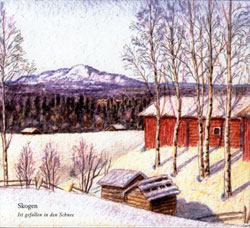
When Swedish composer-pianist Magnus Granberg formed his group Skogen (which means "the forest" or "the woods" in Swedish), he had a unique vision for the group: "The music should be like an environment, perhaps a forest in which inhabitants with different characteristics could move freely in accordance with the environment and their own and each other's properties and abilities." Granberg has achieved this aim beautifully with the CD Ist gefallen in den Schnee, the title originating from a line in a Schubert song that means "Has fallen in the snow."
Skogen's seven members are joined on this recording by the American violinist Angharad Davies and the brilliant Japanese innovator Toshi Nakamura. The unbroken stretch of sound, sixty-one minutes in total, is a stunning piece of music that achieves a wonderful marriage of organic and inorganic elements. Using cello, piano, vibraphone, two violins, crotales, selected percussion, bowls, glasses, objects, contact microphones, and a mixing board, as well as Nakamura's famous no-input mixing board, Ist gefallen in den Schnee creates a singular world with a mysterious atmosphere. It sounds like the Scandinavian countryside waking up, with branches crackling under a deer's foot, or snow falling on snow as the first rays of sunlight hit a branch. However, it could just as well be the sound of robots walking on Pluto, ensconced in a cocoon of dynamic electric silence.
But wherever these sounds might take place, there's something very peaceful about this music, a sparse elegance that soothes the soul. Occasionally the sounds thicken and get insistent, but these brief interludes always dissolve into the encompassing forest. The music often goes note by note, offering up individual sounds with copious space in between. The piano offers a few repetitive motifs, as well as occasional plinks and ghost chords, and the vibraphone provides peaceful echoes reminiscent of church bells. There are also bits and edges of noise, blips and quiggles and squirrelly somethings with fabulous grains and textures. Sometimes long electronic notes create a field for the other sounds, and sometimes the electronic hum is just a hint in the background. These electronic noises are with us daily, but Nakamura has a way of stretching them into poetry; he merges perfectly with the rest of Skogen, respecting the musicians' artistry while simultaneously turning their sounds inside out and backward.
A charming aspect of this music is the way it accommodates environmental sounds. If the neighbors start hammering or perhaps a fire truck races by, this piece has the ability to welcome those noises; it's a truly open field where there's no such thing as an interruption. And because there's something so natural and lifelike about the music, it's also a peaceful support for reading or conversation, which is something that cannot always be said about improvised music performed by a nonet.
Magnus Granberg and Skogen have indeed created a luminous forest that embraces and delights in sound, and altogether Ist gefallen in den Schnee is a beautifully choreographed piece, an immensely open creation that's both welcoming and incredibly compelling.
Comments and Feedback:



More Recent Reviews, Articles, and Interviews @ The Squid's Ear...


|

